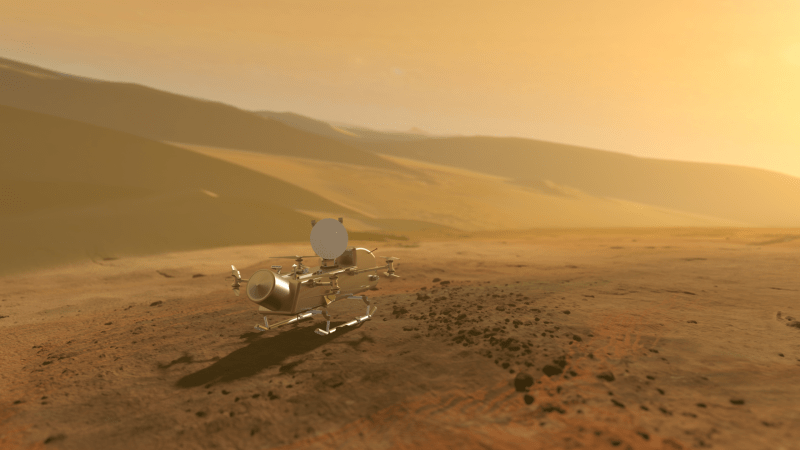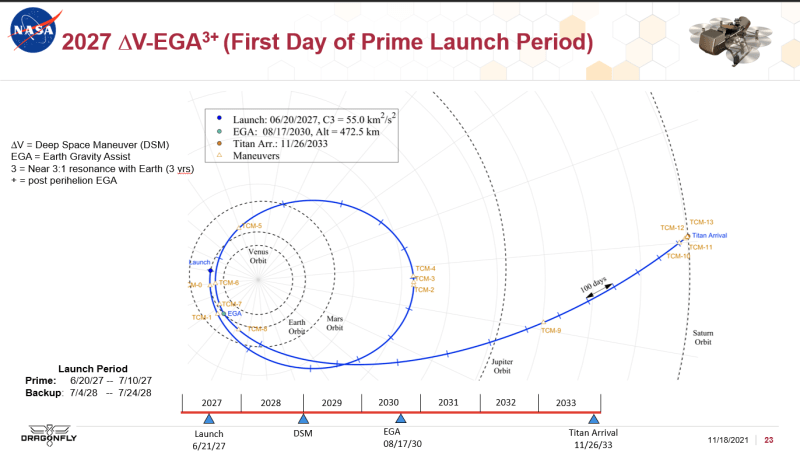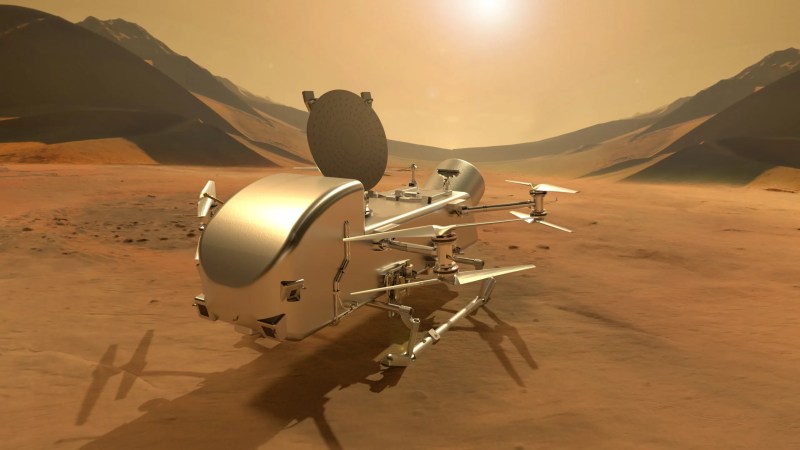Dragonfly Sets Sights on Titan

Credit: NASA Goddard
The NASA Dragonfly mission, a groundbreaking endeavor aiming to explore Saturn’s moon Titan, is making significant progress towards launch in 2028. Johns Hopkins’ Applied Physics Laboratory is moving forward with the design, build and checkout of this revolutionary spacecraft, which will explore a distant world so familiar yet so alien – one which could hold the clues to understanding our place in the universe.
Dragonfly was selected in 2019 as part of the agency’s New Frontiers program, which includes the New Horizons mission to Pluto and the Kuiper Belt, Juno to Jupiter, and OSIRIS-REx to the asteroid Bennu. The mission beat several other noteworthy competitors, including CAESAR – a comet sample return mission to 67P/Churyumov-Gerasimenko. Dragonfly is led by Principal Investigator Elizabeth Turtle, who is based at Johns Hopkins University’s Applied Physics Laboratory in Laurel, Maryland. New Frontiers supports missions that have been identified as top solar system exploration priorities by the planetary community, while operating at a lower cost cap than NASA’s Flagship class missions. The New Frontiers program is managed by the Planetary Missions Program Office at NASA’s Marshall Space Flight Center in Huntsville, Alabama, for the agency’s Planetary Science Division in Washington.

Credit: NASA
The Dragonfly mission is currently set to launch in June 2028 on a launch vehicle comparable to a Vulcan VC2, with its arrival at Titan planned for 2034. Initially planned for launch in 2026, and later 2027, the mission has slipped due to several constraints in design and funding. The rotorcraft will fly to dozens of promising locations on Titan looking for prebiotic chemical processes common on both Titan and Earth. Dragonfly’s historic mission to Titan will be the first time NASA will fly a multirotor vehicle for science on another world. Differing from past designs, the spacecraft utilizes eight rotors and flies like a large drone as opposed to the helicopter-like Ingenuity on Mars. It will take advantage of Titan’s dense atmosphere – four times denser than Earth’s – to become the first vehicle ever to fly its entire science payload to new places for repeatable and targeted access to surface materials, revolutionizing the understanding of a planetary body. This builds on the legacy of successful mobile science platforms such as rovers, which have championed planetary science for decades.
NASA has been dealt a difficult hand in the design, development and implementation of the mission as it has moved from the drawing board to physical spacecraft. The New Frontiers program competes with other NASA programs and priorities for resources, including funding, launch opportunities, and personnel. Balancing these competing demands while advancing the program’s objectives remains an ongoing challenge, made all the more apparent by the funding crunch of FY2023 and 2024. As of the time of writing, no New Frontiers missions that are still active remain in their prime phase; New Horizons, Juno and OSIRIS-REx/APEX have been extended to ensure continuing science without new spacecraft being launched. The Dragonfly mission is currently in the phase of final mission design and fabrication, known as Phase C, as of fiscal year 2024. A major milestone was the successful completion of its Preliminary Design Review earlier in the year, which led to a re-plan of the mission based on the expected funding. This has resulted in an updated launch readiness date, now targeted for July 2028, with formal confirmation of the mission’s details anticipated in mid-2024 following the FY 2025 President’s Budget Request. However, once Phase-C is cleared, the mission will become a top priority for the Planetary Science Directorate within the agency.

Credit: NASA/APL
At November 2023’s meeting of the Outer Planets Assessment Group, NASA’s Director of Planetary Science Dr. Lori Glaze stressed the impacts of uncertain funding on the agency – with several projects running the risk of delays and ballooning costs. Official confirmation of the mission is yet to be solidified, with the FY2025 budget outlining the funds necessary to do so. This uncertainty leaves the mission vulnerable, should funding needs not be met, but many in agency leadership expect the mission to proceed through confirmation. Work in 2024 will include meeting with launch vehicle service providers to select the rocket that will ultimately launch Dragonfly to Titan. However – the Jet Propulsion Laboratory, while not the prime center for this mission, faced a steep round of layoffs early in 2024, a sign of potentially broader things to come agency wide should funding become an issue over the next several years. Other large science missions, such as the flagship-class Mars Sample Return program, have already begun to reassess the scope of their plans in the face of such dire financial constraints, while several members of Congress have urged NASA leadership to stay the course.

Credit: NASA/APL/OPAG
Several elements of the mission’s design are incredibly novel, necessitating new and innovative approaches to problems. Cruise is one of the first areas where the team has been forced to innovate, relying on a novel power tap from the mission’s Multi-Mission Radioisotope Thermoelectric Generator. Thermal management is also a concern during cruise, as the radioactive MMRTG will need active temperature control to ensure that the spacecraft remains healthy Once at Titan, the mission will involve a lengthy entry, descent, and landing (EDL) sequence on Titan, leveraging the moon’s dense atmosphere and lower gravity. The nearly 105-minute EDL sequence will see the spacecraft enter using a large heat shield, similar to the flown systems onboard the Genesis and OSIRIS-REx spacecraft. Following peak heating and deceleration, the system will deploy a series of parachutes to help slow the spacecraft to subsonic speeds over the course of more than an hour, before the ultimate test of the rotocraft’s systems can begin. Dragonfly’s first flight will be a trial by fire, with the EDL system releasing the rotorcraft to perform its first autonomous powered flight to a safe landing zone. This approach, while radical in terms of traditional EDL sequences, enables a full checkout of the design in flight conditions, something that is nearly impossible to replicate on Earth.

Credit: NASA/Langley/APL
Once on the surface of Titan, the exploratory phase of the mission can begin. During its 2.7-year baseline mission, Dragonfly will explore diverse environments, from organic dunes to the floor of an impact crater where liquid water and complex organic materials key to life once existed in a stable state. Titan’s unique conditions, with liquid methane rain and a soupy atmosphere, may have generated the conditions required for life to have one day arisen there. Its instruments will study how far prebiotic chemistry may have progressed, following NASA’s recent scientific theme of the search for life. The spacecraft will also investigate the moon’s atmospheric and surface properties and its subsurface ocean and liquid reservoirs. Additionally, instruments will search for chemical evidence of past or extant life. Most of this work, including critical phases of flight, will be autonomous, as the large distances between Earth and Titan results in considerable light delay. Rovers like Curiosity and Perseverance have practiced using autonomous navigation as they traversed Martian terrain, and recent CLPS missions have flown with terrain relative navigation to test automatic hazard avoidance.
Dragonfly’s mission planners took advantage of 13 years’ worth of Cassini data to choose a calm weather period to land, along with a safe initial landing site and scientifically interesting targets. The legacy of Cassini and its mapping of the moon will enable the mission to hit the ground running, targeting a well categorized region to land in. It will first land at the equatorial “Shangri-La” dune fields, a well studied and safe landing zone which is terrestrially similar to the linear dunes in Namibia in southern Africa and which offers a diverse sampling location. Dragonfly will explore this region in shorter flights, building up to a series of longer “leapfrog” flights of up to 5 miles (8 kilometers), stopping along the way to take samples from areas with diverse geography. It will finally reach the Selk impact crater, where there is evidence of past liquid water, organics – the complex molecules that contain carbon, combined with hydrogen, oxygen, and nitrogen – and energy, which together make up the building blocks for life. The rotorcraft will eventually fly more than 108 miles (175 kilometers) – nearly double the distance traveled to date by all the Mars rovers combined, with the potential to fly farther if the mission is extended.
Despite constraints on Earth, NASA’s Dragonfly mission to Titan remains on track for launch in 2028, two years later than initially planned. While a delay is difficult to work with, the promise of Dragonfly’s findings remains tantalizing. An alien world, so similar to an ancient Earth yet entirely different from anything that is familiar, is an ideal site for the space agency to focus their exploration efforts on. Should the mission be successful, this new period of scientific operations at Titan promises to offer valuable insights into the mysterious moon’s potential habitability and the chemistry of life, marking a significant step forward in our understanding of the outer Solar System.
Edited by Beverly Casillas
